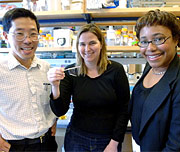Engineering viruses: using biology to assemble materials, devices
To test her idea, Belcher enlisted the help of a very simple organism—a bacteriophage. This hardy, benign virus has single-stranded DNA containing just a few genes that code for specific proteins. “With some genetic engineering, you can add DNA sequences to those genes that’ll add a little protein sequence on the virus,” said Belcher. “It’s really simple.”
The challenge is determining which genes will give the desired behavior. To find out, Belcher and her colleagues insert random DNA sequences into different viruses, put them all in solution, and test their tendency to bind to a sample material. They collect all those that bind, insert them into non-toxic bacteria that replicate millions of copies, and test them again. They repeat the process, changing conditions so that binding becomes harder and harder. “In the end, we take the winner, the one that survives, and then we clone it,” she said. “It’s sort of like having evolution happen on the time scale of a few months.”
Belcher’s team has now “trained” viruses to grow more than 40 semiconductor and electronic materials. They add precursor chemicals to a solution of selected viruses, and each virus grows a solid coating of the target material. Further tweaking has taught the coated viruses to align themselves in neat rows on a solid surface. And inserting several genes into a single virus causes it to grow multiple materials, “sewn” together without defects.


